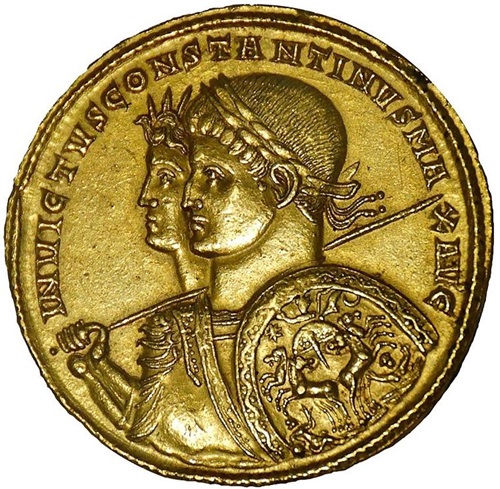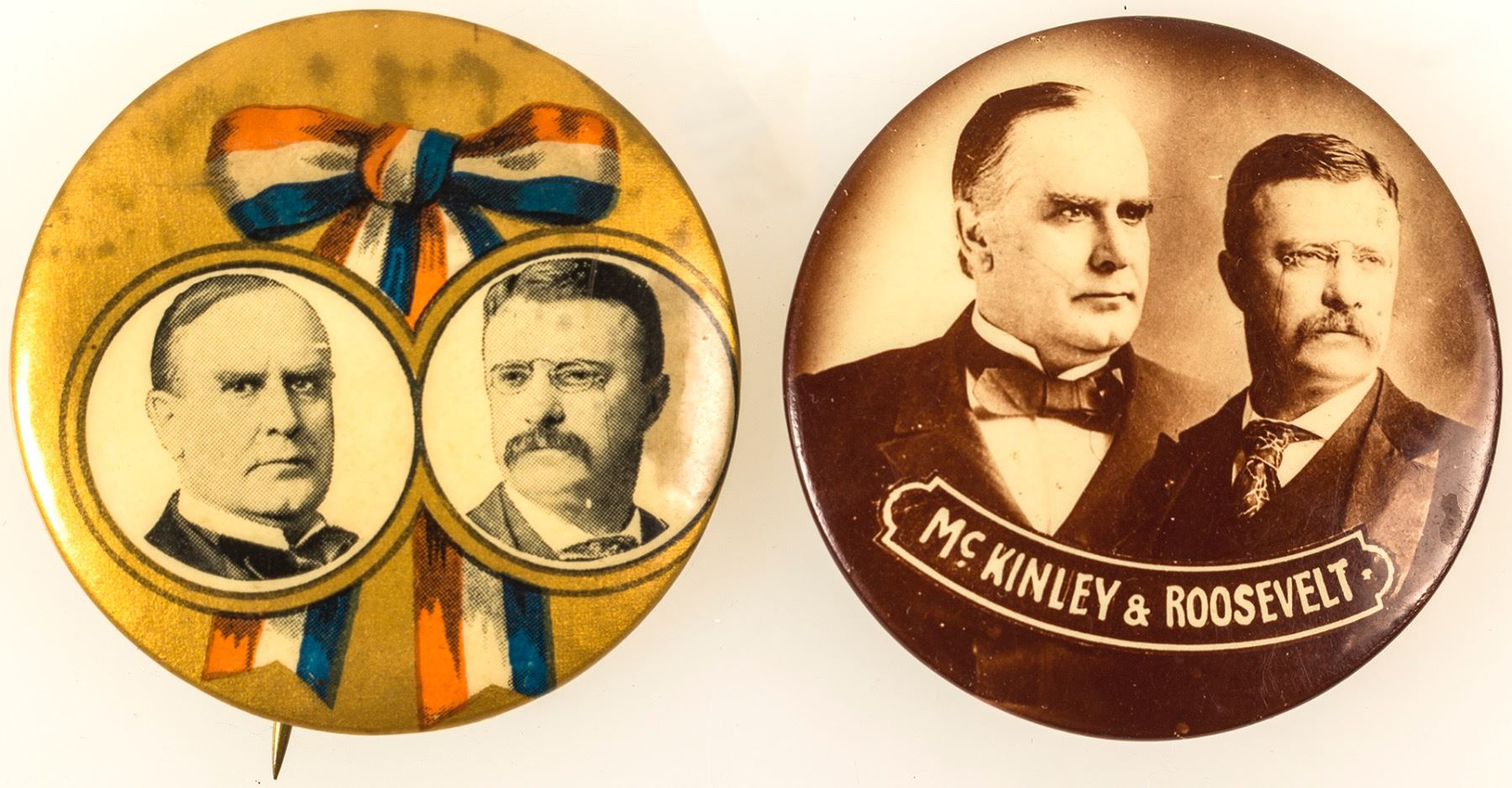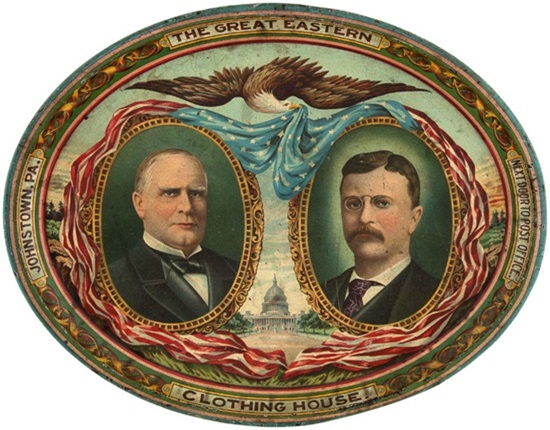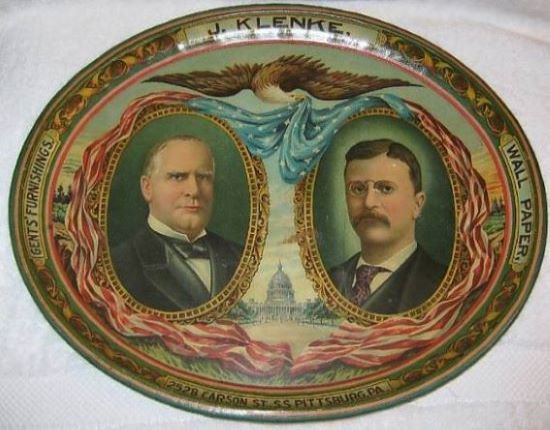The 'Stock' Exchange
Tuscarora Adv. Co. No. 11 "T. Roosevelt & McKinley"
Tuscarora Adv. Co. No. 11 "T. Roosevelt & McKinley"
Date: 1900 - 1903
Size: 16.5" x 11.5"
Type: Plate
Scarcity: Rare
Value: $$$ to $$$$
Condition & Brewer Dependent
Size: 16.5" x 11.5"
Type: Plate
Scarcity: Rare
Value: $$$ to $$$$
Condition & Brewer Dependent
General
Not surprisingly, of all the catalogs and price lists available to us this tray only appears in the 1900 Tuscarora price list, where it is described as “No. 11, Oval 13 ¼ x 16 ¾, McKinley and Roosevelt, ten printings.” Tray pricing was the standard $25.00 per 100 to $200 per 1000 (which translates to $.20--$.25 per tray). We expect it did not appear in any of the yearly catalogs because the design didn’t have a long shelf life since it was related specifically to the 1900 election.
The 29th Presidential election of 1900 was unusual, at least by today’s standards, of being a rematch of the same candidates from 1896—William McKinley vs. William Jennings Bryan - although the Vice-Presidential candidates were different. In the 18th century ematches were actually not that uncommon having occurred four times before the first Mckinley vs Bryan contest, although they only happened once after (Eisenhower vs Adlai Stevenson in 1952 and 1956). The unusual thing about this rematch is it was the first time the same candidate (McKinley) won both times (later Eisenhower did as well). A radically simplified explanation of the two candidates would peg McKinley as a fiscally conservative, pro-business candidate and Bryan as an economically liberal theorist, who championed the cause of “the little guy.”
Although McKinley won both the popular and electoral college votes in 1896, neither were by large margins, so in 1900 without another strong contender, the Democrats again selected Bryan - although after his success at the Battle of Manila Bay, Admiral George Dewey was briefly pushed as an alternative and a few Dewey trays were also produced by a couple of the manufacturers. This example from early tray and sign manufacturer Sentenne & Green from New York.
Not surprisingly, of all the catalogs and price lists available to us this tray only appears in the 1900 Tuscarora price list, where it is described as “No. 11, Oval 13 ¼ x 16 ¾, McKinley and Roosevelt, ten printings.” Tray pricing was the standard $25.00 per 100 to $200 per 1000 (which translates to $.20--$.25 per tray). We expect it did not appear in any of the yearly catalogs because the design didn’t have a long shelf life since it was related specifically to the 1900 election.
The 29th Presidential election of 1900 was unusual, at least by today’s standards, of being a rematch of the same candidates from 1896—William McKinley vs. William Jennings Bryan - although the Vice-Presidential candidates were different. In the 18th century ematches were actually not that uncommon having occurred four times before the first Mckinley vs Bryan contest, although they only happened once after (Eisenhower vs Adlai Stevenson in 1952 and 1956). The unusual thing about this rematch is it was the first time the same candidate (McKinley) won both times (later Eisenhower did as well). A radically simplified explanation of the two candidates would peg McKinley as a fiscally conservative, pro-business candidate and Bryan as an economically liberal theorist, who championed the cause of “the little guy.”
Although McKinley won both the popular and electoral college votes in 1896, neither were by large margins, so in 1900 without another strong contender, the Democrats again selected Bryan - although after his success at the Battle of Manila Bay, Admiral George Dewey was briefly pushed as an alternative and a few Dewey trays were also produced by a couple of the manufacturers. This example from early tray and sign manufacturer Sentenne & Green from New York.


Confirmed Brewer used Stock Trays
Non-Beer Related & Non-Tray Uses
Click the Picture to Return to Meek & Beach Stock Catalog Page
The interesting inclusion of Theodore Roosevelt as McKinley’s Vice-Presidential partner came about due to the death of Vice President Garret Hobart in 1899. Roosevelt had a meteoric rise to this level of national politics starting with his role in the Battle of San Juan Hill (part of the same Spanish-American War as Dewey’s Battle of Manilla Bay) while serving as Assistant Secretary of the Navy in the McKinley Administration. A tray was later produced, probably for Roosevelt own run for the Presidency in 1904 depicting the famous charge up San Juan Hill. That lead to his election as governor of New York in 1898; however, he was not popular with the powers of the New York Republic party (particularly party “boss” Thomas C. Platt) due to his efforts to reform New York politics, including the Republic party. Platt forced McKinley to accept Roosevelt on the ticket in exchange for his support, thus getting the troublesome Roosevelt out of the way.
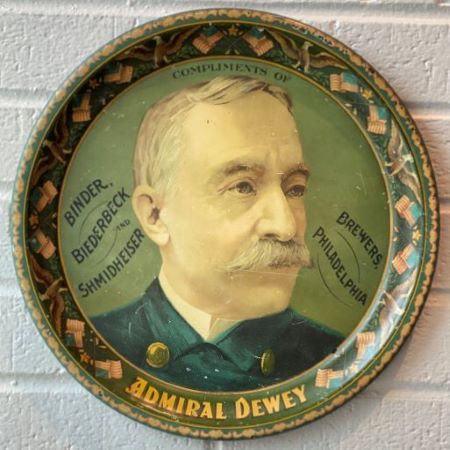
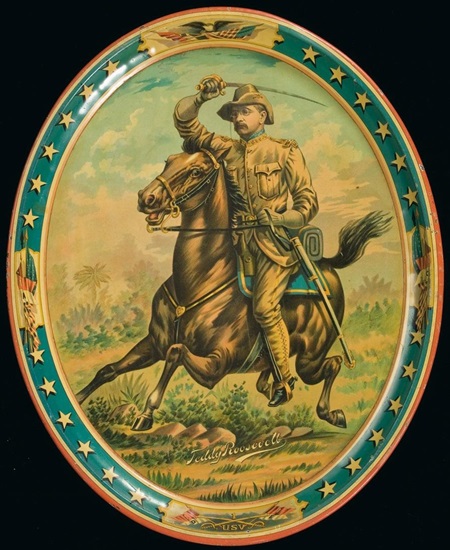
Admiral Dewy
TR Charging San Juan Hill
This style of design, with two individuals depicted together, was briefly popular in the late 18th and early 19th centuries for political campaigns. It was especially true where those candidates were paired on a single ticket, such as President and Vice President as depicted here, although there are examples of national office candidates with affiliated state office candidates. They were known as jugate trays, from the Latin jugatus, meaning joined or demonstrating the closeness of the individuals, and were produced by several of the tray manufacturers of the time. The earliest example of a jugate is a 313AD coin featuring the Emperor Constantine, with a solar deity with purpose of implying Constantine’s divine nature. As campaign items, jugates are more commonly seen on medals, pinbacks, buttons, posters than trays, with pinbacks like this pair that are also from the 1900 Presidential election.
Shape & Rim & Ad Text
To our knowledge this design, like most Tuscarora and early Meek & Beach designs, only comes in one shape and size—oval. There is only one rim design that we’ve observed with the curly-cues and text windows found on other Tuscarora stock designs. What few examples we’ve seen have the advertising text in the rim windows. Given the limited duration of its appeal, we have only seen a handful of examples with advertising text, none from breweries.
Hager & Price
This design is not accounted for in Hager’s catalog of Coshocton trays. In fact, Hager does not include any of the early political trays; only the Theodore Roosevelt tray based on a 1903 John S Sergeant’s painting that was published in Collier’s Weekly and later appeared as stock design No. 47 makes it into Hager’s catalog. This was probably in relation to the 1904 Presidential election. We’ve only seen a few examples of this design with a mixed range of pricing from high double digits for a stock example to high triple figures for one with advertising.
To our knowledge this design, like most Tuscarora and early Meek & Beach designs, only comes in one shape and size—oval. There is only one rim design that we’ve observed with the curly-cues and text windows found on other Tuscarora stock designs. What few examples we’ve seen have the advertising text in the rim windows. Given the limited duration of its appeal, we have only seen a handful of examples with advertising text, none from breweries.
Hager & Price
This design is not accounted for in Hager’s catalog of Coshocton trays. In fact, Hager does not include any of the early political trays; only the Theodore Roosevelt tray based on a 1903 John S Sergeant’s painting that was published in Collier’s Weekly and later appeared as stock design No. 47 makes it into Hager’s catalog. This was probably in relation to the 1904 Presidential election. We’ve only seen a few examples of this design with a mixed range of pricing from high double digits for a stock example to high triple figures for one with advertising.
